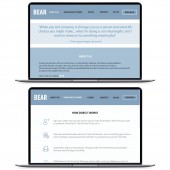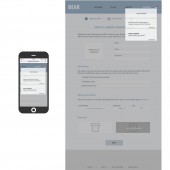DESIGN NAME:
Bear
PRIMARY FUNCTION:
Communication Platform
INSPIRATION:
Grief over death is not a problem that can be fixed. It is, however, a problem with areas that can be improved regarding the end-of-life experience and grief from the death of loved ones. As a person with first-hand experience of the loss of a loved one, I want to find a way to improve the end-of-life experience to help others that are (or will be) going through similar experiences. Design Thinking methods were used as the main guidance throughout the research process and the concept testings.
UNIQUE PROPERTIES / PROJECT DESCRIPTION:
Bear was created with the goals of raising awareness of the need for end-of-life conversations and providing a way for people to have something that represents their loved one to help ease the emotional struggle of bereavement. I created the Bear concept as a platform that allows people to create a Time Pod and prepare for the unknown. Users can add future messages, design how they want to be remembered and customize a Time Pod to help comfort their loved one when they're no longer around.
OPERATION / FLOW / INTERACTION:
Design Thinking process were used as a guideline. The project began with Empathize (research, trying to understand the user), followed by Define (insights formation), Ideate (brainstorming for concept), Prototype (build and design the concept), and Test (Test the ideas).
PROJECT DURATION AND LOCATION:
The research part started in September 2016 in New York. The ideation and strategy part began in February and finished in April 2017 in New York.
FITS BEST INTO CATEGORY:
Office Furniture Design
|
PRODUCTION / REALIZATION TECHNOLOGY:
Tools used for presentations and knowledge map: Adobe InDesign, Adobe Illustrator, pen, and paper.
Tools used for prototype: InVision, Adobe InDesign, Adobe Illustrator, InVision, phone, pen, and paper.
SPECIFICATIONS / TECHNICAL PROPERTIES:
InVision was used as a tool to create the prototype of the platform, along with pen and paper for card sorting, scenario, and general concept testing.
TAGS:
Design Research, Design Thinking, Strategy, Social Impact, Ethnographic Research
RESEARCH ABSTRACT:
Type of research: Interview, survey, focus group, observation, online research. Tools: Voice recorder, phone and computer. Participants: Experts in the End-of-life field, individuals that lost a family member, individuals that never lost a family member.
The research began with a key assumption that there is a lack of acknowledgement of the impact of grief that continues to follow grievers throughout their lives. The insights from the research emerge into the main theme of regrets, expressions, and barrier transformation. As the research journey progressed, it revealed that many experts in the end-of-life industry had lost someone they loved before. Their losses formed new perceptions and got them involved in End-of-Life industry to help others.
By having tools to increase awareness of the importance of preparation for death, users will find a new perspective on appreciating life and the people around them. This will act as the beginning of a domino effect to effectively address end-of-life issues.
CHALLENGE:
One of the most challenging parts of this project was during the research phase. The End-of-Life topic is a sensitive subject for many, and each person grief differently. Some interview participants might feel more uncomfortable sharing their personal story of their loss. During each interview section, participants tone of voice, body languages, and answers had to be monitored closely, and sometimes the interview direction had to change to remain respectful to the participant.
ADDED DATE:
2018-03-16 17:43:42
TEAM MEMBERS (1) :
IMAGE CREDITS:
Image #1: Icons created by Visual Glow US from Noun Project, Tahsin Tahil from Noun Project, National Park Service Collection from Noun Project.
Image #2: Icons created by IconDots from Noun Project, emma mitchell from Noun Project.
Image #3: Icons created by Ruben Semedo from the Noun Project, David from the Noun Project, Alfa Design from the Noun Project, ISRAA ALI from the Noun Project, National Park Service Collection from Noun Project.
Image #4: Icons created by Ruben Semedo from the Noun Project, ISRAA ALI from the Noun Project, Alfa Design from the Noun Project, Dara Ullrich from the Noun Project, Gregor Cresnar from the Noun Project, National Park Service Collection from Noun Project.
Image #5: Ryo Sato from Noun Project.
|










